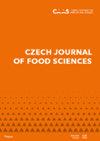食用蘑菇后,生物胺会引起疾病吗?
IF 1
4区 农林科学
Q4 FOOD SCIENCE & TECHNOLOGY
引用次数: 0
摘要
几个毒理学中心报告了一些疾病,主要是消化不便,在摄入可食用的蘑菇物种后。这些投诉的原因尚未得到解释。因此,我们测试了生物胺(BAs)的水平。将广泛食用的野生植物Imleria badia和Suillus variegatus的果体炖熟,然后通过冷冻或罐装保存,最长可保存12个月。在新鲜物质中,在保存的每个步骤中以及在储存过程中测定了六种胺的含量。组胺(HIM)和尸胺(CAD)均未检出。腐胺(PUT)在700 ~ 500 mg kg-1干物质(DM)水平下在新鲜果体中发生,但其含量明显下降,特别是在炖过程中。不良的苯乙胺(PEA)和酪胺(TYM)水平较低。在两种被测试的保存处理中,炖是必要的技术步骤,与灭菌一样减少了所有胺的含量,而随后的储存显示出有限的效果。PUT似乎是唯一一种可以参与报告疾病的胺。本文章由计算机程序翻译,如有差异,请以英文原文为准。
Can biogenic amines cause ailments following the intake of edible mushroom meals?
Several toxicological centres have reported ailments, mainly digestive inconveniences, following the intake of provably edible mushroom species. The causes of such complaints have not been explained yet. We, therefore, tested levels of biogenic amines (BAs). Fruit bodies of widely consumed wild-growing species, Imleria badia and Suillus variegatus were stewed, then preserved by freezing or canning and stored for up to 12 months. Contents of six amines were determined in the fresh matter, in each step of preservation and during storage. Histamine (HIM) and cadaverine (CAD) were not detected at all. Putrescine (PUT) occurred in fresh fruit bodies at levels of 700–1 500 mg kg–1 dry matter (DM), however, its contents considerably decreased, particularly during stewing. Undesirable phenylethylamine (PEA) and tyramine (TYM) occurred at lower levels. Stewing, the technological step necessary in both the tested preservation treatments, reduced the contents of all the amines alike as sterilisation, whereas following storage showed a limited effect. PUT seems to be the only amine that could participate in the reported ailments.
求助全文
通过发布文献求助,成功后即可免费获取论文全文。
去求助
来源期刊

Czech Journal of Food Sciences
Food Science & Technology, Chemistry-食品科技
CiteScore
2.60
自引率
0.00%
发文量
48
审稿时长
7 months
期刊介绍:
Original research, critical review articles, and short communications dealing with food technology and processing (including food biochemistry, mikrobiology, analyse, engineering, nutrition and economy). Papers are published in English.
 求助内容:
求助内容: 应助结果提醒方式:
应助结果提醒方式:


